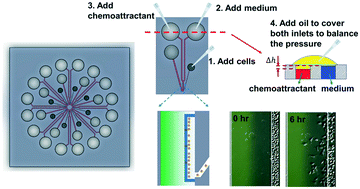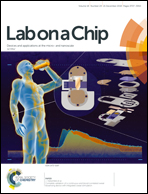A radial microfluidic platform for higher throughput chemotaxis studies with individual gradient control†
Abstract
Chemotaxis plays a fundamental role in immune defense and cancer metastasis. Microfluidic devices are increasingly applied to studying chemotaxis, owing to their advantages of reduced reagent consumption, ability to control chemical gradients, tracking of individual cells, and quantification of chemotaxis. Many existing microfluidic chemotaxis devices suffer from limited throughput and complex operation. Here, we describe a microfluidic device with a radial channel design which allows for simultaneous chemotaxis tests of different cell types and different gradient conditions. This radial microfluidic device was capable of stand-alone stable gradient generation using passive pumping and pressure-balancing strategies. The device was validated by testing the migration of fast-migrating human neutrophils and two slower-migrating human breast cancer cell lines, MDA-MB-231 and MCF-7 cells. Furthermore, this radial microfluidic device was useful in studying the influence of the nuclear chromatin binding protein high mobility group A2 (HMGA2) on the migration of the human triple negative breast cancer cell line MDA-MB-231.



 Please wait while we load your content...
Please wait while we load your content...